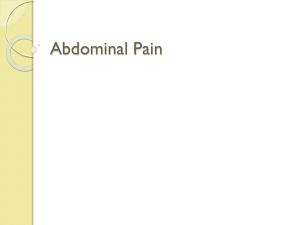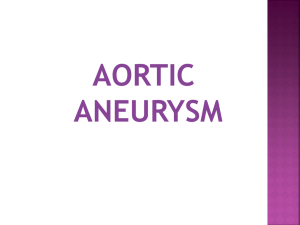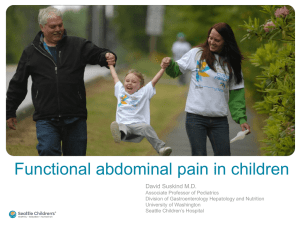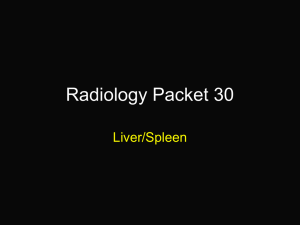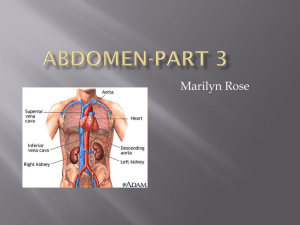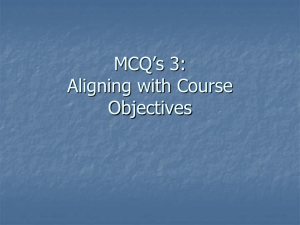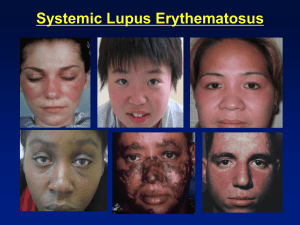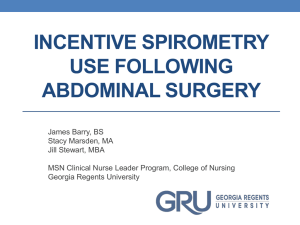Abdominal Pain in the Elderly
advertisement
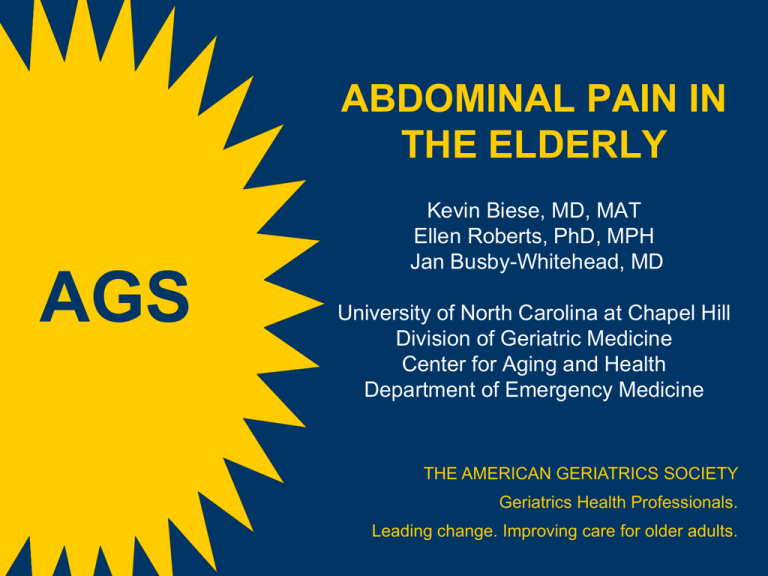
ABDOMINAL PAIN IN THE ELDERLY AGS Kevin Biese, MD, MAT Ellen Roberts, PhD, MPH Jan Busby-Whitehead, MD University of North Carolina at Chapel Hill Division of Geriatric Medicine Center for Aging and Health Department of Emergency Medicine THE AMERICAN GERIATRICS SOCIETY Geriatrics Health Professionals. Leading change. Improving care for older adults. OBJECTIVES • To increase appreciation of the variety of presentations of acute abdominal pathology in elderly patients • To appreciate the differences in etiology of acute abdominal pain between elderly and younger patients • To increase proficiency of evaluation and management of elderly patients with acute abdominal pain Slide 2 WHY CARE? Increasing Elderly Population (≥65 Years) Slide 3 WHY CARE? Significant Mortality and Morbidity Of patients ≥65 years old who come to the ED with acute abdominal pain: • 50% admission • 33% surgery • 10% mortality (similar to ST-elevation myocardial infarction) Kizer KW. Am J Emerg Med. 1998;16:357-362. Slide 4 CASE 1: MS. JONES • 85-year-old woman with past medical history of atrial fibrillation, GERD • Chief complaint: abdominal pain that started 8 hours before arrival, sudden onset • Intermittent pain, was able to eat dinner 3 hours after onset without difficulty • Afebrile, vital signs within normal limits (WNL), no vomiting, no diarrhea, normal bowel movement 2 hours before arrival • Exam: mildly tender epigastric and right upper quadrant (RUQ) region without peritonitis, no Murphy’s sign Slide 5 MS. JONES: INITIAL RESULTS WBC count 11.7 Hematocrit 49 Platelets 193 Chemistries WNL Liver function tests (LFTs) WNL Lipase WNL GALL BLADDER DISEASE: ARE LFTS HELPFUL? Total bilirubin, AST, or alkaline phosphate Positive likelihood ratio Negative likelihood ratio All 3 elevated 1.6 0.8 Any 1 elevated 1.2 0.7 Trowbridge RL. JAMA. 2003; 289(1): 80-86. MS. JONES ULTRASOUND Insert ultrasound image of cholecystitis with gall stones, thickened gall bladder wall, and edema. CHOLECYSTITIS • #1 abdominal surgical emergency in elderly • Incidence increases with age • Often only epigastric pain (foregut innervation is visceral) • LFTs often not helpful • Ultrasound is study of choice Slide 9 CASE 2: MS. JONES RETURNS • Ms. Jones returns to the ED 4 days post-op • Chief complaint: RUQ pain • Pain worsened last night, able to eat, general fatigue • Vital signs WNL, afebrile • Moderate tenderness in RUQ Slide 10 MS. JONES: THE RETURN VISIT • Labs including LFTs are WNL • What to do? Slide 11 MS. JONES: THE RETURN VISIT • The diaphragm is an unsecured border; upper abdominal pain can be Acute coronary syndrome Pulmonary embolism Pneumonia Insert CT image of pulmonary embolism CASE 3: MS. SMITH • 80-year-old woman with past medical history of breast cancer, hypothyroidism • Chief complaint: abdominal pain • Sudden onset 10 hours before arrival, right lower quadrant (RLQ) pain constant in location, 10/10 intensity, + diarrhea • Exam notable for moderate RLQ tenderness, Hemoccult negative Slide 13 MS. SMITH: APPENDICITIS Insert CT image of appendicitis. APPENDICITIS IN THE ELDERLY • 5% of acute abdominal cases • Rarely have the 4 classic criteria (anorexia, elevated WBC, RLQ pain, and fever) • Diagnosis often missed (presence of diarrhea or WBC in urine can be misleading) • However, usually have at least RLQ pain Kauvar DR. Clin Geriatr Med. 1993;9:547-558. Storm-Dickerson TL. Am J Surg. 1983;185:198-201. Slide 15 CASE 4: MS. DOE • 67-year-old woman with HTN, COPD, CAD • Chief complaint: abdominal pain • 3 days generalized, intermittent abdominal pain with nausea, vomiting, and diarrhea (n/v/d); no black stools; some urinary hesitancy • Seen by PCP 2 days prior, given phenergan • No apparent distress; exam notable for moderate RUQ and RLQ tenderness • HR 115, BP 160/100, T 37.0 Slide 16 MS. DOE: INITIAL RESULTS • WBC 11.5; o/w CBC WNL • Chemistries 7 and LFTs WNL • UA shows 7 WBC, nitrite negative • Arterial lactate 1.0 • What to do? A diagnostic test was obtained several hours later… Slide 17 LearningRadiology.com, retrieved June 1, 2011. Slide 18 MESENTERIC ISCHEMIA • Classically, pain out of proportion to exam • Risks include atrial fibrillation, hypercoagulable, low-flow, increasing age • Usually arterial; may be venous • Embolus or thrombosis • Sometimes “intestinal angina” • Usually superior mesenteric artery • Multidetector CT scan 77%90% sensitive • Elevated lactate is a late finding (check >1 time) Newman TS. Am Surg. 1998;64:611-616. Horton KM. Radiographics. 2002:22;161. Slide 19 CASE 5: MR. SMITH • 82-year-old man with HTN, chronic renal insufficiency, diverticulosis • History also includes abdominal aortic aneurysm repair • Presents with a 2-week history of flank pain wrapping around to abdomen • Referred by PCP because of abnormal renal CT scan • Vital signs WNL including afebrile, BP 162/80, HR 65 • Obese male in moderate amount of distress • Exam benign, including abdominal exam Slide 20 MR. SMITH: ABDOMINAL AORTIC ANEURYSM (AAA) • Elderly + low BP + abdominal pain = AAA • Get the ultrasound – Fast! • Same risk factors as CAD (men>women) • >3 cm defines, >5 cm rupture risk • What diagnosis to consider if simultaneous rectal bleeding? Insert ultrasound image of enlarged abdominal aorta CASE 6: MS. CONNOR • 80-year-old woman with HTN, anxiety • 2-day history of crampy lower abdominal pain; mild n/v/d • In no apparent distress • Vital signs WNL other than moderate HTN • Exam notable for moderate RLQ tenderness without peritonitis Slide 22 MS. CONNOR: IMAGING LearningRadiology.com, retrieved June 1, 2011. Slide 23 SIGMOID VOLVULUS • • • • • • • Risk factors: chronic constipation, round worms More common in males Abdominal x-ray 65% sensitive Usually presents with crampy left sided abdominal pain Often decompressed with sigmoid scope Can be subtle presentation Time sensitive diagnosis Atamanalp SSJ Gastroenterol Hepatol 2007 Emedicine 2008 CASE 7: MS. LANE • 79-year-old woman with HTN, diabetes • Chief complaint: 2 days of n/v/d • Well-appearing, vital signs WNL • Seen 48 hours ago for n/v/d: 6 WBC in UA, no nitrate, 4 squamous cells, levofloxacin started • Patient took 1 tab levofloxacin, had increased vomiting and diarrhea • Completely benign abdominal exam • WBC 5,000, chemistries WNL, UA WNL Slide 25 MS. LANE: GASTROENTERITIS (I HOPE) • Observed in ED for 5 hours • No vomiting or diarrhea; tolerating POs • D/C with close PCP follow-up • “You do not always have to be right, you just have to have a contingency plan” Slide 26 KEY POINTS • Acute abdominal pain in the elderly is associated with significant morbidity and mortality • LFTs often not revealing in acute gallbladder disease • The diaphragm is not a secure border • Consider mesenteric ischemia (especially with history of atrial fibrillation, pain out of proportion to exam) • Elderly + low BP + abdominal pain = AAA (until proven otherwise) Slide 27 CASE 1 (1 of 2) • An 85-year-old woman presents to the ED complaining of 8 hours of abdominal pain. The pain is centered in the epigastrium and she has had no n/v/d. • She had a normal bowel movement 2 hours before arrival to the ED. She ate a meal last night without difficulty. • Her past medical history is notable for atrial fibrillation and GERD. • In the ED she is afebrile with normal vital signs other than mild HTN at 150/95. Slide 28 CASE 1 (2 of 2) • Her exam is notable for a well-appearing elderly woman with mild epigastric tenderness and no peritonitis on exam. She does not have a Murphy’s sign on exam. • After completing your history and exam, you order labs, including LFTs, CBC, and basic chemistries. Other than a WBC count of 11.7 without a left shift, these labs are all WNL, including the LFTs. • You now need to decide how you wish to proceed with this patient. Slide 29 CASE 1, QUESTION 1 What is the most common etiology of acute abdominal pain presenting to the ED in patients over age 50? Select the one best answer. A. B. C. D. Biliary tract disease Constipation Nonspecific abdominal pain Urinary tract infection Slide 30 CASE 1, QUESTION 2 What is the negative likelihood ratio for all LFTs being normal in assessing whether a patient has acute cholecystitis? A. B. C. D. 0.1 0.3 0.7 1.0 Slide 31 CASE 1, QUESTION 3 True or False: The gallbladder’s visceral innervation originates in the midgut. Slide 32 CASE 2 (1 of 2) • A 67-year-old woman with a medical history of HTN and CAD disease presents to the ED with 3 days of generalized intermittent abdominal pain with n/v/d and some urinary hesitancy. • She denies black stools or fevers. • She was seen 2 days ago by her PCP and given phenergan for nausea. She is now presenting to the ED because her pain is not improving. Slide 33 CASE 2 (1 of 2) • On exam she is in significant pain but has only moderate RUQ and RLQ abdominal tenderness. • She is guaiac-negative on rectal exam and her vitals are notable for a heart rate of 115, BP of 160/100, and temperature of 37.0 C. • In the ED, her WBC count is 11.5 without a left shift, her UA has 7 WBC without nitrite, squamous cells, or bacteria, and the rest of her labs are normal, including her arterial lactate level of 1.0. • You now need to decide how to proceed in your evaluation of this patient. Slide 34 CASE 2, QUESTION 1 Which of the following is NOT a risk factor for mesenteric ischemia? A. B. C. D. Advancing age Atrial fibrillation Prior abdominal surgery Recent myocardial infarction Slide 35 CASE 2, QUESTION 2 True or False: Elevated lactate levels are a highly sensitive marker of mesenteric ischemia. Slide 36 CASE 2, QUESTION 3 Regarding appendicitis, which of the following classic signs and symptoms do the majority of elderly patients with abdominal pain have? Select the one best answer. A. B. C. D. Anorexia Migration of pain Pain localized to the RLQ Peritoneal signs on abdominal exam Slide 37 ANSWER KEY • Case 1 Question 1: A Question 2: C Question 3: False • Case 2 Question 1: C Question 2: False Question 3: C Slide 38 ACKNOWLEDGMENTS AND DISCLAIMER • This project was supported by funds from the American Geriatrics Society John A. Hartford Geriatrics for Specialists Grant. This information or content and conclusions are those of the authors and should not be construed as the official position or policy of the American Geriatrics Society or John A. Hartford Foundation, nor should any endorsements be inferred. • The UNC Center for Aging and Health and UNC Department of Emergency Medicine also provided support for this activity. This work was compiled and edited through the efforts of Jennifer Link, BA. Slide 39 THANK YOU FOR YOUR TIME! Visit us at: www.americangeriatrics.org Facebook.com/AmericanGeriatricsSociety Twitter.com/AmerGeriatrics linkedin.com/company/american-geriatricssociety Slide 40
